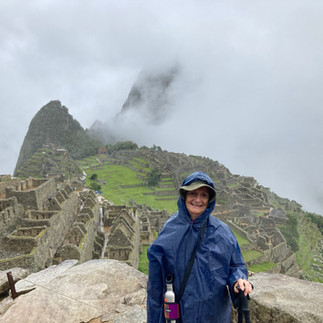Amazing Archeology in Peru
- Peggy Simonsen
- Dec 6, 2023
- 3 min read
“Wherever you are in your journey, I hope you, too, will keep encountering challenges. It is a blessing to be able to survive them, to be able to keep putting one foot in front of the other — to be in a position to make the climb up life’s mountain, knowing that the summit still lies ahead. And every experience is a valuable teacher.” Oprah Winfrey
Peru is famous for Machu Pichu of course, but I learned about so many other ancient archeological sites in the country. We started by exploring the Huaca Pucllano Museo in the city of Lima. It is an active archeological restoration, just discovered in 1981 under a grass-covered hill. The massive structure is made of clay bricks that were stacked vertically and have withstood earthquakes for 2,000 years, predating the Inkan civilization by a thousand years! Entrance includes a guide who helped us understand the impact and value of this find, including burial pits with existing mummies still intact wrapped in ropes.
Joining the Overseas Adventure Travel group and guide, Jose, we were introduced to a huge collection of pre-Inkan and Inkan artifacts in the Larco Museum in Lima. Most were excavated on a property along the coast north of Lima by a landowner in the 20th century, who donated thousands of pieces intact to start the museum. Many artifacts have survived, up to 5000 years old, because of the dry climate-the coast’s last measurable rain was in 1974! There is pottery, masks, shields, even fabric, all of which is decorated by the Condor, which represents the sky, the Puma which represents earth mother Pacha Mamma, and the Serpent, which is safe-the ground.
In the highlands, in Urubamba, we explored Pisac, an Inkan ruin with terraced hillside and irrigation source- an engineering marvel of the Inkas across all their settlements. Inkan temples were always lined up with the sun for solstice, and massive stones were brought on the river from quarries 60 kilometers away. This was the site of one of the first battles with the Spaniards. The Inkas won, but then abandoned the site.
To get to Machu Pichu, visitors must take a train from Ollantaytambo thru the Sacred Valley to the town at the base of the mountain. A bus takes people to the World Heritage Site, spacing huge crowds over the day. I could immediately understand the world-wide interest- the site is incredibly awesome. Built on the top of a 10,000-foot mountain, the stone structures still stand. It was a huge city, with homes, temples, lookout towers, paths, terraces for agriculture, with the stones mostly intact, and only the straw roofs restored. It was inhabited by the Inkans until the 16th C when the final Inka (king) was killed by Pissaro and his invaders. Then it was abandoned until "discovered" by Hiram Bingham in 1930. Locals knew the ancient buildings were there, but it was overgrown and unknown to westerners.
Another site we visited is Tipon, a state archeological park, which has an intact, complicated irrigation system created by the Inkas, still operating after 600 years! And on a hillside outside of Cusco is Saksayhueman (pronounced Sexywoman), a stone fortification built by the Inkas. Massive stones were fitted together without mortar, that has withstood earthquakes. Engineers are still trying to figure out how hundred-ton stones could be moved, let alone lifted into a wall for an ingenious triple-level barricade.
Peru is a must-see for archeological buffs like me, but fascinating for anyone to explore.





















Comments